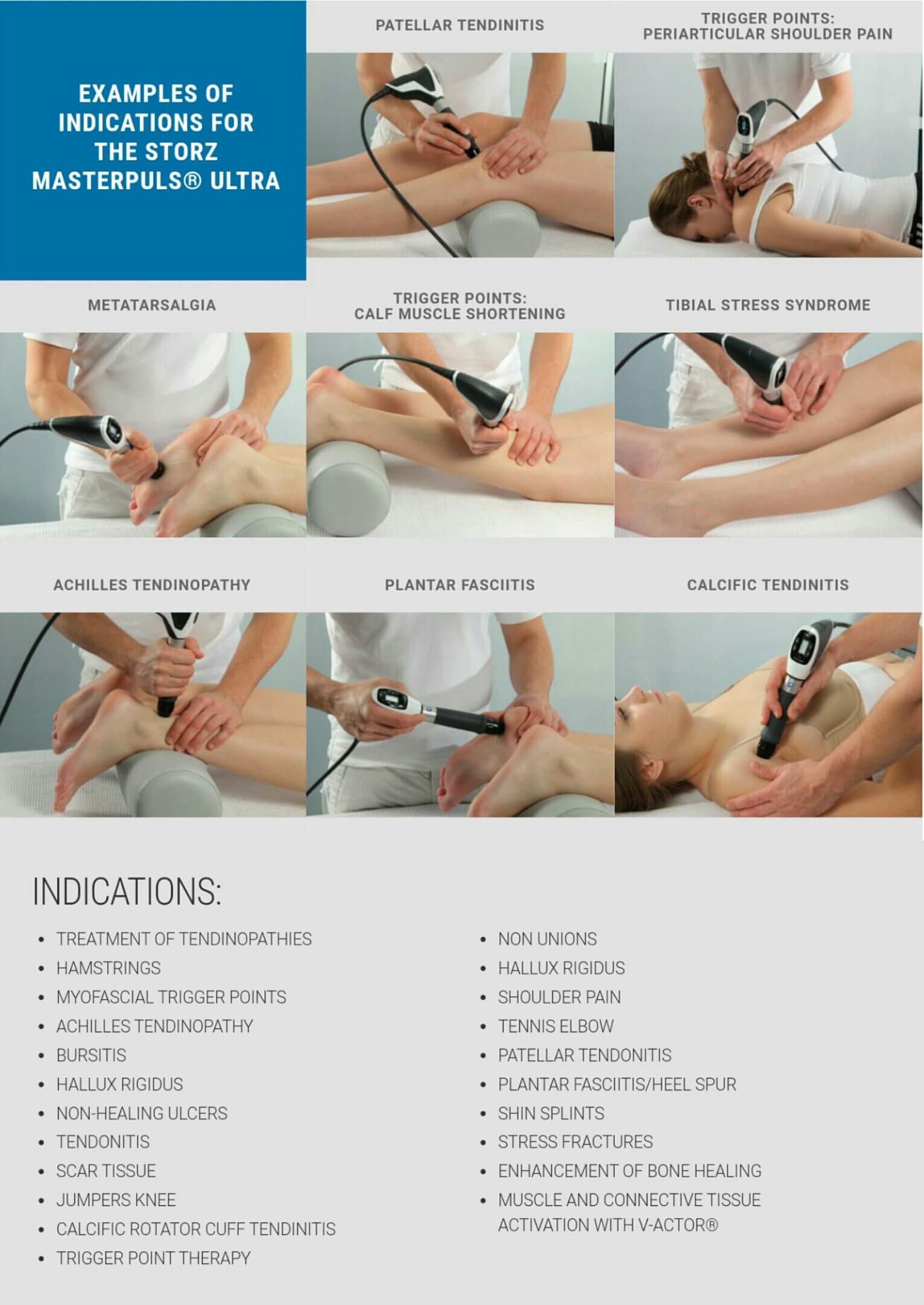Shockwave Therapy – Patient information

Shockwave Therapy – Patient Information
1. What is Shockwave Therapy?
Shockwave therapy is a safe, non-invasive, out-patient alternative to surgery for those suffering from many joint and tendon disorders.
A shockwave is a “high powered sound wave”. Shockwave Therapy sends acoustic shockwaves into bone or soft tissue, in effect re-injuring the area on a cellular level and breaking up the scarring that has penetrated tendons and ligaments. The controlled re-injuring of tissue allows the body to regenerate blood vessels and bone cells. The resulting re-vascularization leads to faster healing, a chemically induced decrease in pain and sensitivity of pain receptors, and often a return to pre-injury activity levels.
2. How does it work?
Shockwave Therapy is particularly good at pain management and elimination. The therapy is effective for three reasons: The shock waves stimulate a metabolic reaction in the affected tissue, causing stress fibers to develop and/or change in their permeability: they generate cavitation bubbles that break down calcific deposits; and they induce an analgesic reaction mechanism, which blocks pain messages.
3. Shockwave Therapy eliminates these possible post-operative complications:
- Extended recovery period
- Nerve Damage
- Rupture
- Permanent scarring
4. Conditions Treated / Who can Benefit:
Everyone with soft tissue injuries can benefit, especially athletes. Shockwave Therapy provides a safe, non-surgical alternative for those suffering from:
- Plantar fasciitis & heel pain
- Tennis elbow
- Hip pointers/tendonitis
- Calcific tendonitis of the shoulder
- Rotator cuff tendonopathy
- Knee patellar tendonitis
- Achilles tendonitis
- Frozen/Stiff Shoulder
- Whiplash
- Headaches
- Iliotibial Band Syndrome
- Shin Splints
- Trigger Points / Fibromyalgia
- Chronic Muscle Tension
- Bursitis anywhere
5. Clinical Success Rate and Effectiveness :
There have been more than 300 articles published on Shockwave Therapy, including 10 double-blinded, randomized, controlled trials. The evidence for the use of Shockwave Therapy is overwhelming.
Recent clinical studies suggest there is an 80% – 85% chance this technology will improve your condition provided you are a good candidate for Shockwave treatment
- 91%IMPROVEMENT FOR CALCIFIC TENDINITIS
- 83%IMPROVEMENT FOR CALCIFIC TENDINITIS OF THE SHOULDER
- 77%IMPROVEMENT FOR TENNIS ELBOW
- 76%IMPROVEMENT FOR ACHILLES TENDINOPATHY
- 90%IMPROVEMENT FOR PLANTAR FASCIITIS
- 80%IMPROVEMENT FOR RADIAL AND ULNAR HUMERAL EPICONDYLITIS
- 88%IMPROVEMENT FOR PATELLAR TENDINITIS/ ACHILLODYNIA
- 80%IMPROVEMENT FOR MYOFASCIAL TRIGGER POINTS
6. How Safe is Shockwave?
Very Safe! Shockwave therapy has no long-term side effects or damages. Some short-term discomfort is felt during the treatment and some patients may experience temporary soreness, tenderness or swelling for a few days following the procedure. Others may experience mild bruising, tingling or numbness over the area of treatment. Upon completion of your treatment you can return to most regular activities almost immediately, however for certain conditions we may advise you to avoid heavy strenuous activities for a day or two. Occasionally, pain or discomfort may persist for a few days following treatment but no serious complications or side effects have been reported.
7. Number of Treatments:
The number of Shockwave Therapy treatments required often varies depending on the severity and chronicity (how long you have had the condition). Many patients report that they start to feel relief and a decrease in symptoms after just the first couple of treatments.
Shockwave Therapy is so effective that in many cases only require 4-5 treatments, only once every week, which minimizes your time at therapy, and won’t interfere with your busy lifestyle.
Some chronic conditions may require between 8 to 10 treatments once per week, and this usually depends on how long you have had your condition. We will assess your condition and provide you with an estimate of the amount of treatments that historically has been appropriate to effectively treat your condition, and prevent it from returning again.
After the treatment sessions are finished the injured area continues to heal for 6 to 18 weeks with maximal recovery occurring approximately 3 months after the treatment sessions end.
8. Contraindications:
- Coagulation disorders
- Use of anticoagulants (esp. Marcumar)
- Thrombosis
- Tumor diseases, carcinoma patients
- Pregnancy
- Polyneuropathy (in the case of DM)
- Acute inflammations
- Children in growth
- Cortisone therapy up to six weeks before first treatment in the target area
- Pacemakers
- Over metal implants
9. What to do/what not to do before and after Shockwave Therapy:
Please do not take anti-inflammatories or administer topical anti-inflammatories prior to the Shockwave treatment.
If you have had a cortisone injection you will need to wait 6 weeks post injection prior to commencing Shockwave Therapy
Copyright by Bloom Laser Clinic 2019. All Rights Reserved.
Copyright by Bloom Laser Clinic 2019. All Rights Reserved.


